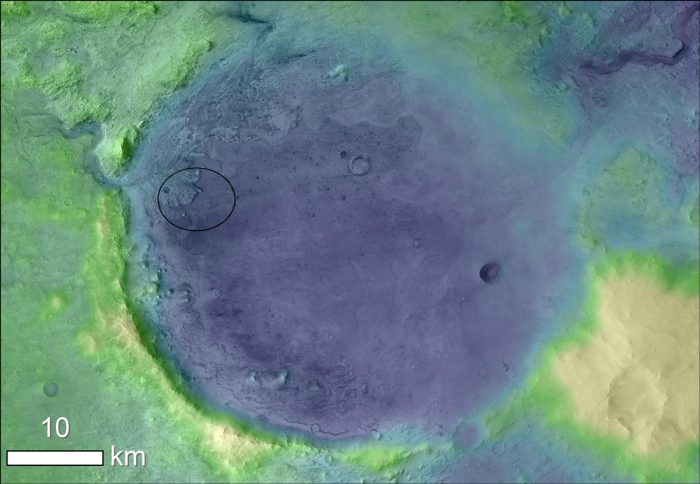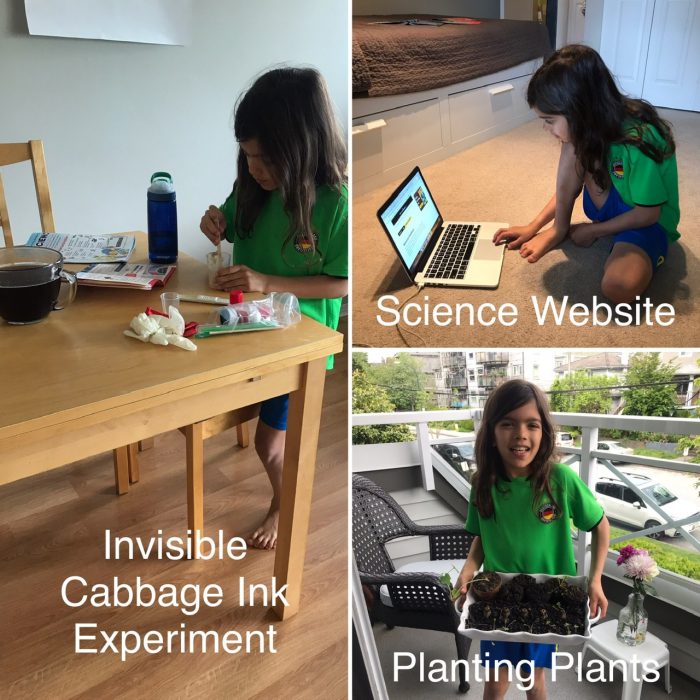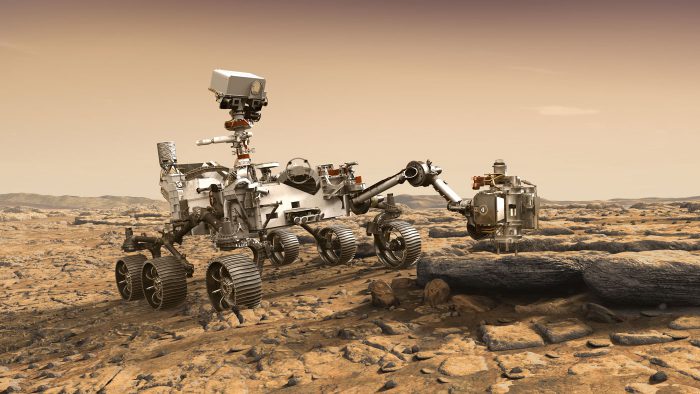On Thursday, July 30, NASA's latest Mars rover was launched. Perseverance will take seven months to reach Mars, landing in the Jezero Crater on Feruary 18, 2021.
Once it arrives there it will join Curiosity, another rover that has been on Mars since 2011.
Mars is a big planet! Much larger than even an army of rovers could explore. And while Perseverance is similar to Curiosity at first glance, it is carrying an arsenal of cool new tech.
And it is taking that tech to a location potentially full of thrilling discoveries.
Not a zero—What's so great about Jezero Crater?

An image of Jezero Crater with its delta circled. (NASA)
In choosing a mission to a new planet, the launch site is everything. Even moving probes like rovers don't travel very far. Despite being on Mars for almost 3,000 days, Curiosity has only traveled about 23 km (14 miles).
For Perseverance, NASA scientists chose Jezero Crater as its home. Millions of years ago, Jezero was once a crater lake, full of water. Researchers can not only see where rivers had flowed in and out of it, they can see the deposit of the river delta, an area where a river flows into a larger body of water. As the faster moving river hits the lake or sea, it slows down and any sediment—particles of dirt, sand, or rock—being carried by the river settles to the seafloor. On Earth, delta deposits are rich in ancient buried organic materials.
And on Mars? There's only one way to find out. But if there are signs of ancient life to be found, a place like Jezero Crater's delta is an ideal place to look.
What's on board?
Perseverance has been loaded with all kinds of cool gadgets, many of which have never been seen on Mars.
It's bringing a helicopter drone, called Ingenuity. This sidekick should add extra capabilities to Perseverance during its mission, allowing it to get better perspective on its environment ... and even itself (aerial selfie time!).
It will also bring instruments to record sound on Mars for the first time. And while scientists aren't expecting to record wild birds calls or anything, it will be pretty amazing to finally listen in on the Red Planet as well as see photos and video.
And maybe most amazing? The rover is aiming to not only analyze Martian soil—it's going to try and send them back to Earth! This will be a very complex process, of course. It begins with the rover sealing samples in tubes. The idea is that future missions will be able to collect these samples and one day send them our way. And even if it likely won't get here until 2031, we've never been more excited about the idea of receiving some dirt.
To learn more about the rover and its groundbreaking mission, watch this video below!
Science Odyssey Contest Winners!

One of the Science Odyssey Grand Prize winners, Kiran Mysra, surrounded by a lot of science activities! (Courtesy of winner)
While its safe to say that Perseverance is on a science odyssey, it's also not the only one.
Earlier this year, along with our friends at NSERC, we challenged you to embark on your own learning adventures—the 2020 Science Odyssey Contest! Kids across Canada told us about three science-related activities they did. We received many wonderful entries and want to thank everyone who participated.
And now we'd like to share with you the deserving winners!

Grand Prize winner Lauren Clifford did this cool soil experiment. (Courtesy of winner)
GRAND PRIZE WINNERS:
Kyran Misra – BC
Lauren Clifford – ON
RUNNERS UP:
Serena Mallery — BC
Carly Ducharme – ON
Peyton Brownlee – AB
Nathan Huynh – AB
Fiona McClorey – ON
George Rowley– ON
 An artist's impression of Perseverance on the surface of Mars. (NASA)
An artist's impression of Perseverance on the surface of Mars. (NASA)










Congratulations winners 😀